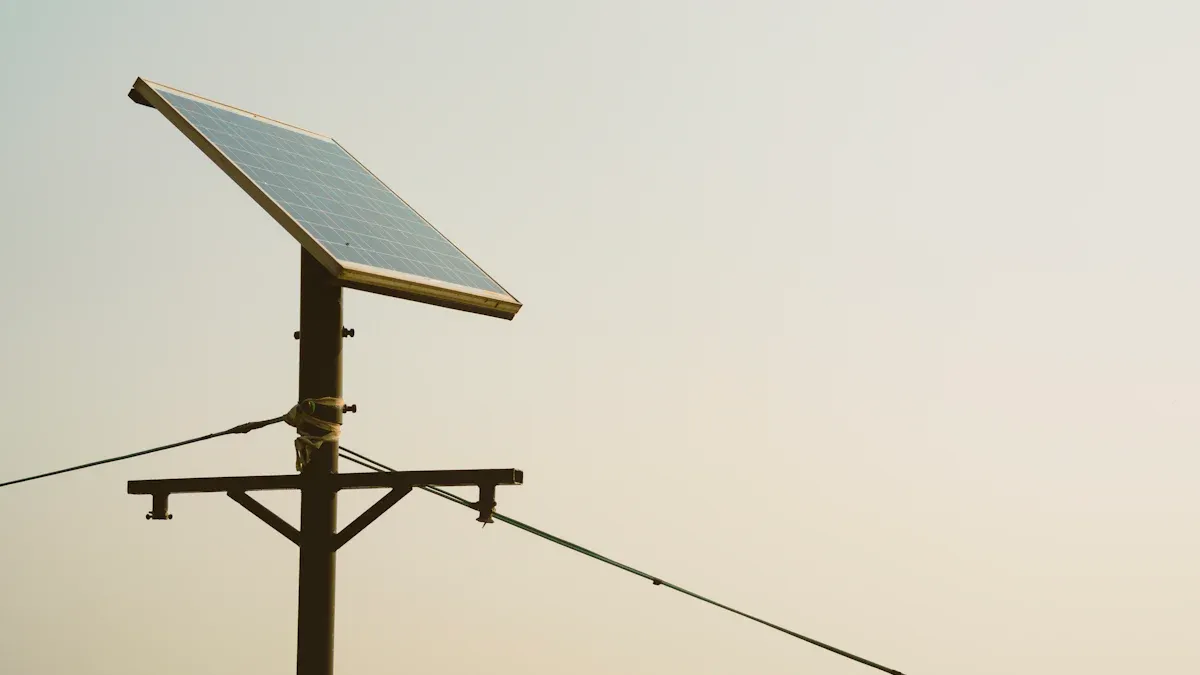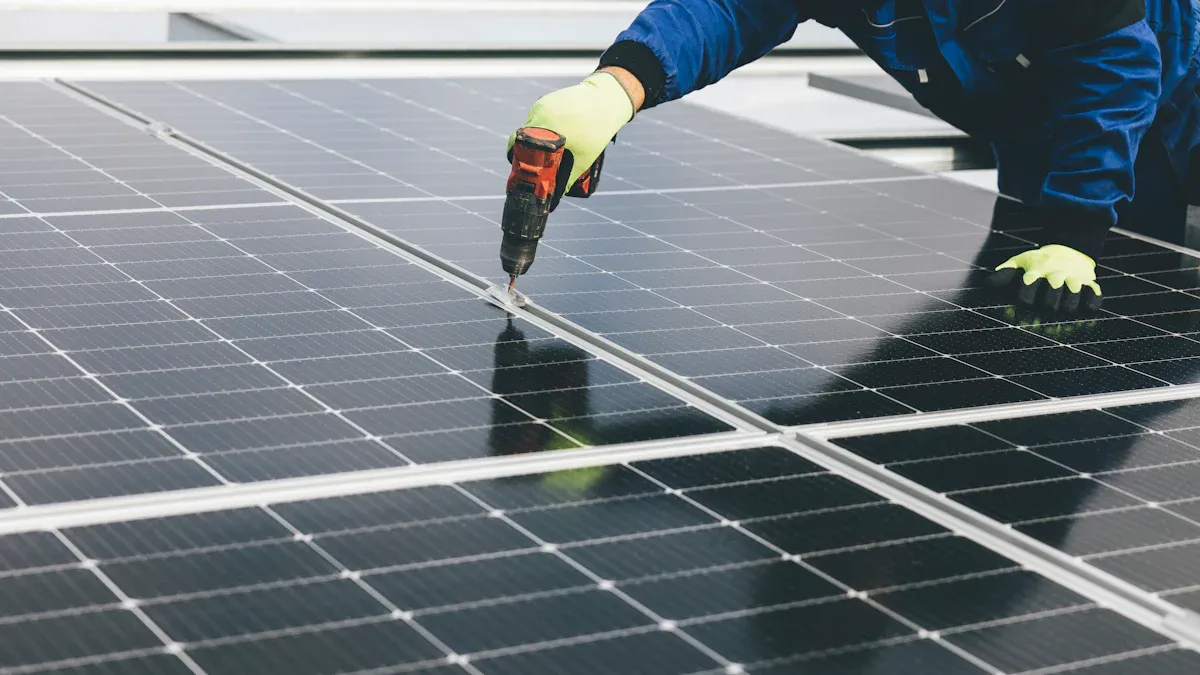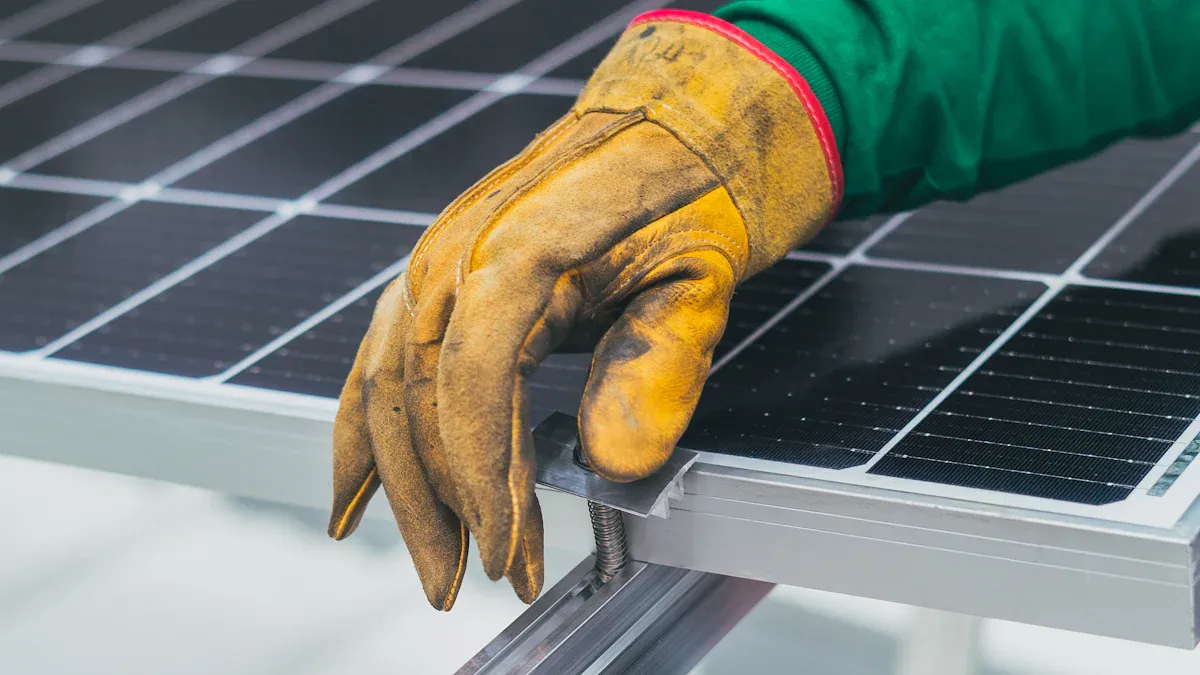Steel Structure for PV Panel: Lightweight, Intelligent, and Customized Innovations

Steel Structure for PV Panel solutions now leverage lightweight alloys, intelligent monitoring, and modular customization to meet the demands of modern solar installations. Durability and adaptability drive adoption, with aluminum making up over 70% of rooftop systems and steel dominating utility-scale projects. Advanced materials extend panel lifespan by 40%, while AI-driven predictive maintenance systems achieve 98% fault prediction accuracy. These innovations reduce downtime and boost energy yields by up to 25%.
Key Takeaways
Steel structures for PV panels combine strength, durability, and lightweight materials like aluminum to support various solar projects efficiently.
Advanced coatings and corrosion-resistant steels extend the lifespan of solar mounts, reducing maintenance and protecting against harsh weather.
Smart tracking systems and IoT monitoring boost energy output by up to 25% and help detect issues early, lowering downtime and repair costs.
Modular and prefabricated steel designs speed up installation, cut labor costs, and adapt easily to different terrains and project sizes.
Customizable steel structures blend durability with aesthetic options, making solar installations both reliable and visually appealing.
Steel Structure for PV Panel

Material Innovations
Recent advancements in steel structure for PV panel systems have transformed the solar industry. Manufacturers now use industrial-grade alloy steel, galvanized steel, and aluminum plates to achieve a balance between strength, weight, and durability. Stainless steel has become a preferred choice for solar racks, especially in environments that demand high strength and corrosion resistance. Aluminum remains popular for rooftop installations due to its light weight and ease of handling, but it cannot match the load-bearing capacity of steel in large-scale projects.
Note: Precision fabrication and modular designs allow steel structures to adapt to various terrains and panel types, supporting both bifacial and concentrated solar power systems.
The following table compares the most common materials used in steel structure for PV panel applications:
Material | Cost | Corrosion Resistance | Durability | Strength and Use Case |
|---|---|---|---|---|
Galvanized Steel | Affordable | Moderate (suitable for most climates) | Good | Cost-effective, zinc coating protects against rust; suitable for general outdoor use |
Stainless Steel | Higher upfront cost | Excellent (ideal for extreme conditions) | Exceptional | Superior corrosion resistance and durability; ideal for coastal/high humidity areas; supports larger modules due to greater strength |
Cold-Formed Steel | Cost-effective | Good resistance to harsh environments | Durable | Strong and affordable; shaped at room temperature to enhance load-bearing capacity |
Brands like ESTEL have set industry benchmarks by offering steel structure for PV panel solutions that combine competitive pricing with advanced features. Their products include active cooling, customizable layouts, and weatherproof construction. These features extend the lifespan of solar installations and ensure reliable performance in harsh outdoor conditions. ESTEL’s adaptability and compliance with industry standards make their solutions suitable for a wide range of renewable energy projects.
Corrosion Resistance
Corrosion resistance remains a critical factor in the long-term performance of steel structure for PV panel systems. Galvanized steel uses a zinc coating to shield against rust, maintaining structural integrity even if the surface gets scratched. Stainless steel provides exceptional resistance to corrosion, making it ideal for coastal or high-humidity environments. Advanced coatings, such as epoxy, polyurethane, and zinc-rich layers, create barriers that protect steel from moisture, salt, and temperature extremes.
Regular inspections and maintenance, combined with high-quality coatings, can extend the service life of steel structures beyond 35 years, even in severe environments.
Innovative materials and treatments, such as Hempel’s Avantguard 750 Pro, use a combination of barrier, inhibitor, and galvanic effects to deliver superior protection. These coatings reduce maintenance frequency and structural degradation, supporting the long-term sustainability of solar installations. The integration of recycled materials and precision surface treatments further enhances corrosion resistance, contributing to lower environmental impact and improved durability.
Installation Benefits
Steel structure for PV panel systems offer significant installation advantages. Lightweight steel components, such as I-beams and studs, simplify handling and reduce labor effort. Pre-engineered and prefabricated parts arrive ready for assembly, minimizing on-site shaping and errors. This approach cuts construction time nearly in half compared to traditional methods and lowers labor costs.
Pre-cut and pre-drilled kits enable fast, straightforward assembly.
Off-site fabrication delivers consistent quality and reduces construction waste.
Standardized connections and modular designs allow for easy adaptation to different project requirements.
Aluminum brackets, while lighter and easier to install, suit smaller rooftop systems. Galvanized steel brackets, with higher bearing capacity, support industrial and ground-mounted solar arrays. The choice between materials depends on balancing weight, strength, corrosion resistance, and installation complexity. Durable steel structures also reduce long-term insurance and maintenance expenses, making them a cost-effective solution for large-scale solar projects.
Intelligent Design
Smart Tracking Systems
Modern steel structures for PV panels now support advanced smart tracking systems that maximize solar energy capture. These systems use robust steel frameworks to enable both single-axis and dual-axis movement, ensuring panels maintain optimal alignment with the sun throughout the day. This dynamic positioning increases energy output by 10–30% compared to fixed systems. Steel’s strength and resistance to wear allow these trackers to operate reliably, even in harsh weather.
Smart PV tracker solutions, such as those from SolarGik, bring several innovations to the field. The following table highlights key features and their impact on energy yield and installation efficiency:
Feature / Benefit | Description / Impact on Energy Yield and Installation Efficiency |
|---|---|
Short Table Size (6-24 panels) | Enables precise tracking and improved backtracking, boosting energy yield in diverse environments. |
2-in-Landscape Configuration | Reduces backside shading to 3.5%, increasing bifacial panel production. |
Installation on Slopes up to 30% | Allows deployment on uneven terrain, raising power density and enabling use of challenging sites. |
Small, Reliable Motors (30+ year life) | Cuts weight and cost by 20-30%, lowering capital expenses and improving project economics. |
Lightweight, Modular Design | Supports dual-use applications, such as rooftops and Agri-PV, maximizing land use. |
In-house SCADA System (SOMA) | Optimizes tracking angles in real time, maximizing output and profitability. |
Zero-Maintenance Design | Ensures durability and reduces operational costs, supporting sustained energy production. |
Steel structures provide the necessary durability for these systems, supporting smooth operation and reducing maintenance concerns. Trackers also optimize land use, generating more power within the same footprint and adapting to complex terrain. Intelligent control systems, equipped with advanced sensors, deliver precise sun tracking and smart wind protection, further enhancing reliability.
Real-Time Monitoring
IoT integration has revolutionized the monitoring of PV panel steel structures. Sensors embedded in the system collect real-time data on temperature, irradiance, dust accumulation, and operational status. This information flows to centralized platforms, where AI algorithms analyze it to detect anomalies and optimize maintenance schedules.
IoT sensors monitor dust, solar radiation, and weather conditions, optimizing cleaning cycles.
Automated cleaning triggers only when necessary, improving efficiency and reducing downtime.
Remote monitoring and control allow operators to receive real-time updates and intervene quickly.
These systems have demonstrated a 30% increase in panel output by maintaining cleanliness and preventing efficiency loss.
Automated alerts notify operators about potential issues, reducing response times and minimizing manual inspections.
Operators can oversee maintenance activities and make adjustments remotely, reducing labor costs and supporting proactive maintenance strategies. This approach ensures consistent energy production and extends the lifespan of both the panels and their supporting steel structures.
Predictive Maintenance
Predictive maintenance strategies now play a crucial role in the long-term performance of steel structures in solar installations. Advanced materials, such as galvanized and stainless steel, reduce the need for frequent repairs. High-strength steels provide lighter, stronger mounts, enhancing structural integrity.
Real-time monitoring with embedded IoT sensors detects early faults and reduces unexpected breakdowns.
Corrosion-resistant coatings extend the lifespan of steel structures and minimize degradation.
Automated monitoring and maintenance schemes lower labor costs and extend system life.
Regular visual inspections identify potential issues early, reducing inspection costs.
Automated cleaning and robotic methods optimize maintenance efficiency and reduce labor dependency.
Preventive maintenance focuses on components with higher failure rates, such as inverters, to improve overall reliability.
AI-driven algorithms analyze performance parameters, such as output power and temperature, to predict faults before they occur. Automated alerts and remote diagnostics enable targeted interventions, reducing downtime and unexpected repair costs. These strategies collectively enhance system performance, lower operating expenses, and support sustainability in solar PV systems with steel structural components.
Customization Trends

Modular Solutions
Steel structures for PV panels now feature modular designs that streamline construction and enhance project flexibility. Manufacturers use automation and robotics in metal building production, which improves quality and efficiency. Prefabrication and modular construction reduce on-site time and waste, leading to faster project completion and consistent results. Metal buildings provide inherent strength and flexibility, supporting large open spaces ideal for PV panel integration. Energy-efficient steel production and recycled materials contribute to sustainability in these modular systems.
Automation and robotic welding ensure precise fabrication.
Prefabricated components minimize on-site labor and errors.
Modular systems adapt to various project sizes and layouts.
Integration with tracking systems increases energy capture.
California’s Energy Code now requires new school buildings to include solar PV and battery storage, driving the adoption of high-performance, solar-ready modular designs. These trends support energy efficiency and sustainability in both public and private sectors.
Project Adaptability
Prefabricated and adjustable mounting systems give steel structures the adaptability needed for diverse project sites. Modular ground mounting systems allow flexible installation and expansion, accommodating projects of any size. Adjustable mounts modify height, tilt, and layout to optimize solar exposure and power output. These systems suit various roof types, terrains, and environmental conditions, including agriculture and aquaculture farms.
Quick installation with prefabricated parts saves time.
Adjustable features optimize performance for unique sites.
Universal components ensure compatibility with different PV modules.
Lightweight structures reduce roof loads and footprint.
Steel structures also excel in challenging environments such as boats, carports, and remote locations. Customizable options—like dimensions, door styles, and ventilation—address specific needs. Steel’s durability and resistance to weather extremes ensure long-lasting protection and security.
Aesthetic Options
Aesthetic considerations play a growing role in the adoption of PV panels. Metal facade panels now serve as both protective cladding and energy-generating surfaces, blending seamlessly with traditional and modern architectural styles. These panels offer superior thermal performance and weather resistance, while supporting sustainable design goals. Solar canopies and carports combine visual appeal with functionality, enhancing both residential and commercial spaces.
Architects can choose between galvanized steel and aluminum to balance durability, corrosion resistance, and visual integration. Customizable layouts and flexible designs allow solar structures to harmonize with their surroundings. Successful urban projects show that well-designed solar installations can serve as both energy generators and attractive architectural elements, encouraging broader adoption of PV technology.
Applications and Benefits
Efficiency Gains
Steel Structure for PV Panel systems drive efficiency in solar installations across commercial and industrial sectors. Steel’s high strength and load-bearing capacity allow for optimal panel orientation, which maximizes sunlight exposure and energy yield. Manufacturers design steel mounting structures for both ground-mounted and rooftop systems, supporting a wide range of project sizes. Precision engineering ensures secure fitting, which minimizes structural issues and supports consistent energy production. Corrosion-resistant coatings and advanced weatherproofing protect steel in harsh environments, reducing downtime and repair costs. These features contribute to significant lifecycle cost savings and improved return on investment.
Operators report up to 25% higher energy output when using smart tracking and modular steel structures compared to traditional fixed systems.
Durability
Steel Structure for PV Panel solutions offer exceptional durability in diverse climates. Steel frameworks provide stability against high winds, heavy snow, and intense heat. Manufacturers use corrosion-resistant materials, such as marine-grade steel and advanced coatings, to protect against moisture, salt, and UV radiation. Structural features like shorter cantilever lengths and symmetrical layouts enhance resistance to environmental stresses. Engineering for hurricane-grade wind resistance and snow load management ensures long-term integrity. Regular maintenance, including inspections and tightening of fasteners, extends system lifespan. Smart monitoring systems detect structural issues early, reducing repair costs and prolonging operational life.
Steel structures adapt to regional climates, optimizing durability and energy output.
Locking fasteners and through bolting prevent loosening from vibrations or thermal expansion.
Modular designs allow for easy upgrades and repairs.
Case Studies
Real-world projects demonstrate the versatility and benefits of steel structures in solar applications:
Kinter Electric in Sunnyside, WA, installed a 60 kW rooftop solar system on metal roofs, reducing energy bills for commercial buildings.
An assisted living facility in Olympia, WA, uses a 15 kW steel solar carport system, providing renewable energy and shaded parking.
PG Farms in Salisbury, Maryland, operates a 235 kW ground-mounted steel solar array, offsetting 100% of the farm’s electricity use and supporting energy independence.
The HelioWing 7 Solar Carport in Maryland delivers clean energy, shaded parking, and enhanced property value, with options for battery storage and integrated LED lighting.
Global trends show that pre-engineered metal buildings now feature built-in solar mounting tracks and integrated energy storage. These innovations reduce installation costs, support sustainability, and enable flexible solar deployment in commercial and industrial settings.
Lightweight, intelligent, and customized steel structures drive efficiency, durability, and adaptability in PV panel installations. ESTEL’s modular, corrosion-resistant designs enable rapid assembly and long-term reliability, even in harsh climates.
Industry experts recommend:
Selecting steel for strength and adaptability to diverse load conditions.
Matching structure type to PV module and architectural needs.
Considering wind, snow, and seismic loads for safety.
Ensuring compliance with local codes and standards.
Future Innovation Area | Description |
|---|---|
Technological Advancements | AI-powered tracking, self-cleaning mounts, and lightweight composites. |
Sustainability | Carbon-neutral, recyclable, and modular structures. |
Installation Efficiency | Automated assembly and 3D-printed components. |
Ongoing innovation in steel structures will continue to align with global sustainability goals and expand the possibilities for solar infrastructure.
FAQ
What materials work best for steel structures in PV panel systems?
Galvanized steel, stainless steel, and aluminum offer strong performance. Galvanized steel suits most climates. Stainless steel resists corrosion in harsh environments. Aluminum provides lightweight support for rooftops. Project requirements determine the best choice.
How often should operators inspect steel PV structures?
Operators should inspect steel structures at least twice a year. Regular checks help identify corrosion, loose fasteners, or structural shifts. Early detection prevents costly repairs and extends system lifespan.
Can steel structures be customized for unique project needs?
Manufacturers offer modular and adjustable designs. These solutions adapt to different terrains, roof types, and site conditions. Customization ensures optimal performance and visual integration for each project.
Are steel PV structures cost-effective compared to other options?
Steel structures provide long-term value. Their durability, low maintenance, and high load capacity reduce lifecycle costs. Initial investment may be higher than some alternatives, but long-term savings and reliability offset upfront expenses.
See Also
Essential Structural Design Considerations For ESTEL Outdoor Cabinets
Latest Developments Shaping Outdoor Telecommunication Cabinets Today
Best Materials To Use For ESTEL Telecom Cabinets In 2025
Ensuring Safety In Custom ESTEL Outdoor Telecom Cabinet Designs
Innovative Sustainable And Intelligent Outdoor Communication Cabinets 2025
CALL US DIRECTLY
86-13752765943
3A-8, SHUIWAN 1979 SQUARE (PHASE II), NO.111, TAIZI ROAD,SHUIWAN COMMUNITY, ZHAOSHANG STREET, NANSHAN DISTRICT, SHENZHEN, GUANGDONG, CHINA


